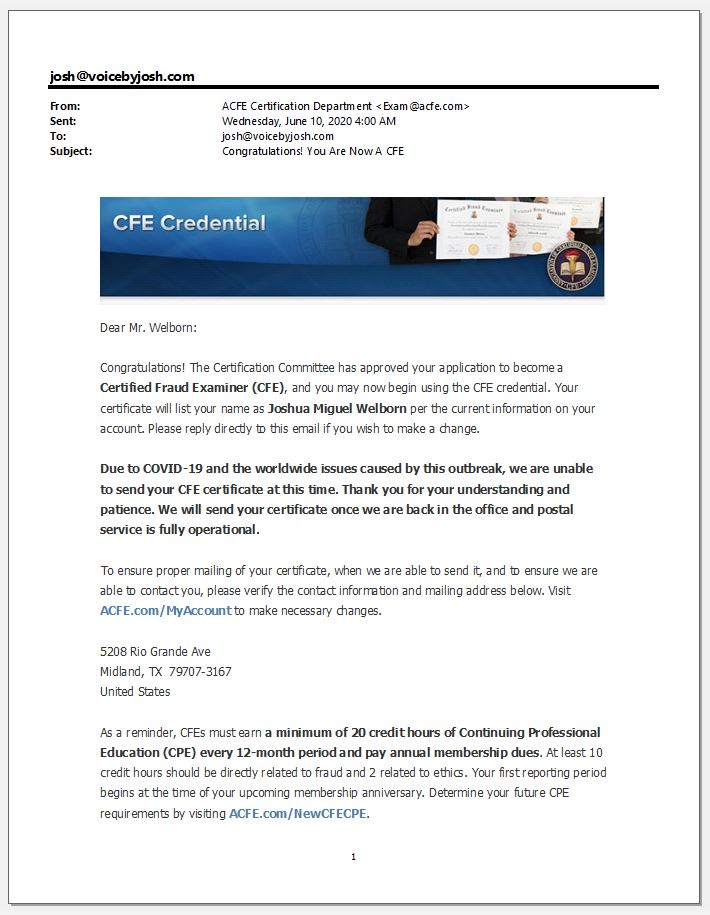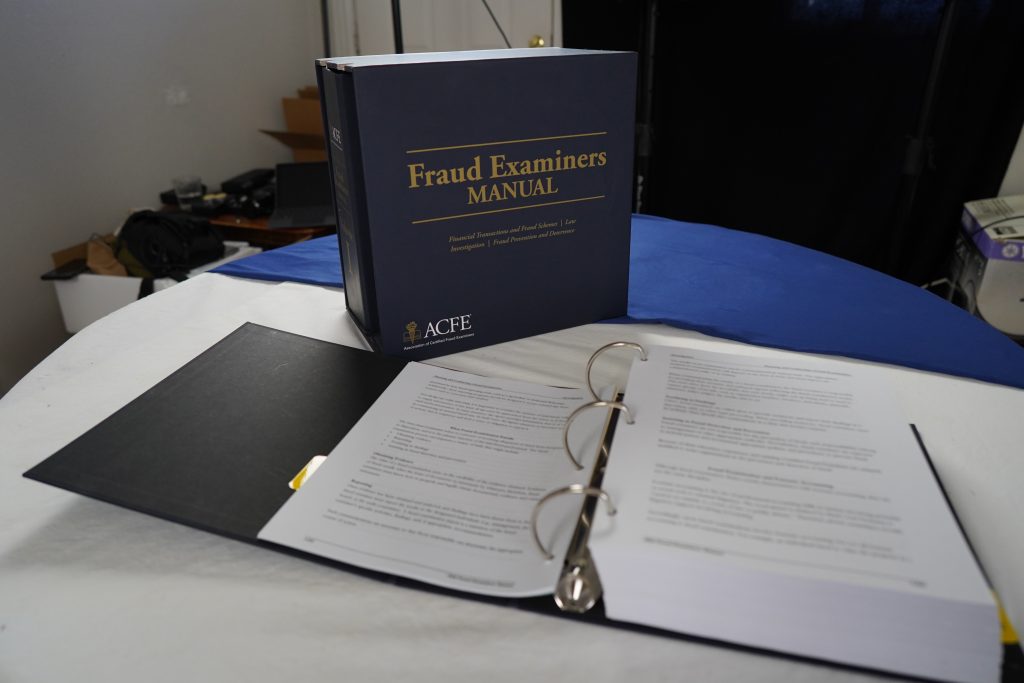05/18/2020 – 5:48:49 PM
My update. I have passed all of the ACFE practice exams consistently with a minimum of 83 percent, and a high of 93 percent respectively. I feel these are comfortably above the pass fail threshold of 75 percent.
Last Saturday I kept my calendar open to take at least two of the exams whilest the rest of the family was out at the park. However and unfortunately, the ACFE uses a grossly incompetent exam proctoring service called Examity. This so called service, requires you to install a half thought-out app into your Chrome browser. This viru…I mean app then controls your microphone, and webcam so that you can be monitored during the exam. After going through the oceans of complaints tied to this company online, I learned that the system uses some sort of AI to read your eye movements, and ‘listens’ to the background to make sure no-ne is giving you the answers.
So yeah, basically, the ACFE requires you to allow someone to be hacked into your computer – a stranger no less – so that they can see you and your browser, while also listening to your microphone.
You would think the ACFE would have great respect for the cautionary teachings from fraudulent-masterminds-turned-good such as the late Frank Abagnale. A man whom I’ve had the pleasure of attending one of his anti-fraud and identity theft conferences. To think the ACFE expects one willfully give the keys to their computer desktop, webcam and microphone to a stranger and employee of a shockingly poor reviewed exam proctoring service is astounding. Additionally the app you must install into your browser is such a half baked piece of trash that I have no confidence in its ability to resist being exploited by those even more nefarious than Examify themselves. For example, once I installed the app, it used the rearward fcing webcam on my surface rather than the front facing. There were no setting whtsoever in the app itself, so I hd to waste valuable minutes of my life (that I would have rather spent taking dump) having to reach out to the enemy itself for guidance…which was…go into device manager and disable the rear facing camera.
Wow.
Also, what kind of security protocols do Examify use to prevent hackers from infiltrating their user’s machines? You will not find any of this information on their website, now will you be able to call any kind of customer support directly. They really are, this bad.
But, you know what, I studied like hell for this exam, and I decided the pros of honouring the hundreds of hours of preparation for the CFE exam outweighed the risks inherent with installing this Examity garbage onto my machine.
So, after taking a prctice run-through of the exam on Examity’s websute, and having my system check out as ‘good to go’, and taking a picture of my drivers license along with a pic of myself (yep, it gets that personal), I was presented with a screen with a big blue button that said “Begin Exam”.
Here we Go! Show time!!!
Nothing happened.
At this point in this blog entry, I will copy and paste the following transcript of my discussino with the Examity chat-based technical support, for your review…
Kikelomo F (5/16/2020, 1:24:29 PM): Thank you for contacting Examity Support. Can you confirm your first and last name as well as the school or organization you are testing with?
Josh (5/16/2020, 1:25:16 PM): Josh Welborn ACFE. Exam started but I do not see anything
Kikelomo F (5/16/2020, 1:25:28 PM): Hello Josh
Kikelomo F (5/16/2020, 1:25:46 PM): for how long has it been like that?
Josh (5/16/2020, 1:26:34 PM): I clicked Begin Exam and nothing has happened
Josh (5/16/2020, 1:26:44 PM): It has been like this for about 4 minutes
Kikelomo F (5/16/2020, 1:26:54 PM): ok
Kikelomo F (5/16/2020, 1:27:32 PM): I will check things up but it is typically about that long
Josh (5/16/2020, 1:27:58 PM): Ok thank you
Kikelomo F (5/16/2020, 1:28:17 PM): Please share the exam ID
Josh (5/16/2020, 1:29:01 PM): You mean the exam key?
Kikelomo F (5/16/2020, 1:29:36 PM): no, the exam ID is all numbers. You should see it in your examity account
Josh (5/16/2020, 1:30:04 PM): session_ID=P8922799287 maybe this?
Kikelomo F (5/16/2020, 1:31:47 PM): International 2020 – Law, is this the exam?
Josh (5/16/2020, 1:32:00 PM): should I just hit close on the exam?
Kikelomo F (5/16/2020, 1:32:08 PM): International 2020 – Law, is this the exam?
Josh (5/16/2020, 1:32:18 PM): yes that it correct
Kikelomo F (5/16/2020, 1:32:22 PM): ok
Kikelomo F (5/16/2020, 1:32:34 PM): yes you need to close the window
Josh (5/16/2020, 1:32:46 PM): Will this result in a fail?
Kikelomo F (5/16/2020, 1:33:05 PM): the exam is now pending at the auditor and you will not be able to access it again
Josh (5/16/2020, 1:33:48 PM): Why??
Kikelomo F (5/16/2020, 1:33:49 PM): fail, not sure. The auditor decides that. But I believe you should be able to reschedule
Josh (5/16/2020, 1:34:52 PM): Who can I call? I have n idea what happened, the exam did not launch, and now I cant take it. I have made arrangements this weekend to get this done, please
Kikelomo F (5/16/2020, 1:35:07 PM): while the exam was launching, the verification was on
Kikelomo F (5/16/2020, 1:35:47 PM): During the verification, you got 3 yellow flags
Josh (5/16/2020, 1:37:08 PM): What were the flags? Ive been sitting here, trying to get this test to open.
Josh (5/16/2020, 1:38:12 PM): Do you think wearing reading glasses may have tripped it up?
Kikelomo F (5/16/2020, 1:39:28 PM): Please refer to the exam guidelines on this, However, if you are able to complete the exam without your glasses, I will advise you do without it
Josh (5/16/2020, 1:40:30 PM): Who can I call? This is unacceptable. I need to ake my exams. Your system appears to be broken. And I cannot get any usable information
Josh (5/16/2020, 1:40:50 PM): Do you have an international number?
Kikelomo F (5/16/2020, 1:41:45 PM): At this point, you need to reschedule and to do that you need to reach out to ACFE
Josh (5/16/2020, 1:42:51 PM): Am I able to take a different exam? When will the auditors compelte their review? Where can I get information as to what the flags were?
Kikelomo F (5/16/2020, 1:45:16 PM): The auditing takes 1-3 days
Josh (5/16/2020, 1:45:44 PM): Can you tell me what the flags were??????????????????????????????????/
Josh (5/16/2020, 1:45:56 PM): Do you have a phone number??????????????????????????????????????????????????????????????????????
Kikelomo F (5/16/2020, 1:46:47 PM): You will get the report from the auditor
Josh (5/16/2020, 1:46:54 PM): Is it possible to take another one of the exams???????
Kikelomo F (5/16/2020, 1:47:18 PM): Let me check that. Please give me a moment
Josh (5/16/2020, 1:48:52 PM): Great! Thank you
Kikelomo F (5/16/2020, 1:49:56 PM): Please contact ACFE student services at (800) 245-3321
Kikelomo F (5/16/2020, 1:51:29 PM): they will be in a better position to answer your questions. On the technical side of thing, if you reschedule and want to take the exam or any exam again, please clear your cache and cookies
Kikelomo F (5/16/2020, 1:51:45 PM): and ensure the pop-up blocker is disabled
Josh (5/16/2020, 1:52:48 PM): So if I try to put another exam key in for one of the other exams, you cant tell me if it will result in the same issue? Does this mean I should stop trying for the weekend? ACFE is closed until Monday. I have no idea what my options are! I need assistance. Can you patch me through to your manager?
Kikelomo F (5/16/2020, 1:54:05 PM): Please go ahead and try, the success of that depend on how ACFE set things up. If a key can only give you access to an exam, then it will not work
Josh (5/16/2020, 1:55:13 PM): Do you have a manager I can please chat with.
Kikelomo F (5/16/2020, 1:55:16 PM): I know you want a resolution to the issue but we do not have managers in chat support and the issue will be resolved by ACFE
Josh (5/16/2020, 1:57:38 PM): Can you please tell me then…what can I do to ensure that if I try to take another part of the ACFE exam today, that I will not get another set of yellow flags? Your system offers no feedback at.all. I have nio idea why the flags were issued. IF I had not contacted you, I would still be waiting for the exam to launch,. This is incredibly frustrating. I want to take the exam I have prepared for.
Kikelomo F (5/16/2020, 1:59:46 PM): The information you need will be provided after the auditing process is complete
Kikelomo F (5/16/2020, 2:00:14 PM): on any other exam, please ensure you follow the exam guidelines
Kikelomo F (5/16/2020, 2:00:38 PM): limit all physical and eye movements
Josh (5/16/2020, 2:00:44 PM): What about taking another part of the exam today?
Josh (5/16/2020, 2:01:51 PM): I followed all of the guidelines. Without having feedback as to what the flags were, I have no idea what to change.
Kikelomo F (5/16/2020, 2:02:00 PM): Please go through the guidelines in details
Josh (5/16/2020, 2:02:31 PM): Yes I did that. This is why Ive been chatting with you.
Josh (5/16/2020, 2:02:49 PM): Are you unable to tell me what the flags were?
Kikelomo F (5/16/2020, 2:03:14 PM): That is determines in auditing
Kikelomo F (5/16/2020, 2:03:54 PM): Please wait for the exam auditing to be complete and any needed feedback will be provided
Josh (5/16/2020, 2:04:45 PM): Thank you for your time.
After this colossal waste of time, and at the end of my rope in frustration, I sent the following email to the ACFE. I have not heard back from them yet, but hopefully their response will yield some sort of light in the tunnel.
Here is the email:
From: josh@voicebyjosh.com <josh@voicebyjosh.com>
Sent: Saturday, May 16, 2020 2:57 PM
To: ‘memberservices@ACFE.com’ <memberservices@ACFE.com>
Subject: Examity Issues and Assistance Request
Dear sir or madam.
I would like to express to you how difficult a time I have had trying to take the ACFE exam through your Examity partners.
After fielding over 2000 questions, taking and passing multiple practice exams, and scheduling time in my busy household to take the ACFE exam, I was unable to answer even one question through the Examity portal. After sharing my screen and clicking the ‘Begin Exam’ button, nothing happened. When I went to customer support, they gave no indication as to what happened, only that flags were raised, my exam has gone to audit, and that I must now wait three to four days in order to find out what the problem was.
I also do not know if this will count as a test taken, and if so, if it will be counted as a fail.
Again, this is without having answered one single question. As a result, the accommodations I have made to take the exam this weekend are now completed negated. This means new arrangements will need to be made to take the exam next weekend, all without even knowing what the issue was. I have four children in my home, three of whom are not able to go to school due to the quarantine here in the UK. This makes it crucial that issues such as these do not arise. If the fault is mine, I will gladly take responsibility. But I have no idea why these flags occurred and my 30 minute discussion went in several frustrating circles (please see the attached transcript).
I am heavily dependent on the ACFE to provide a fair, and reliable testing system for me to use. So far, Examity does not seem to fit this bill, and in my opinion they do not reflect well on this organization of which I am a proud member of.
Can you please assist me in ensuring I get a fair chance to take the exam I have spent well over one month preparing for.
Thank you,
Josh
P.S. FYI, my computer passed the Examity system check, and I have taken the Examity 10 question practice exam, which went without issue.
We’ll see what happens…



